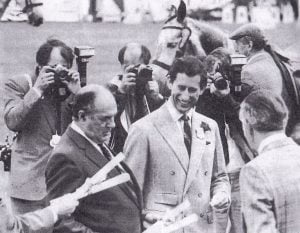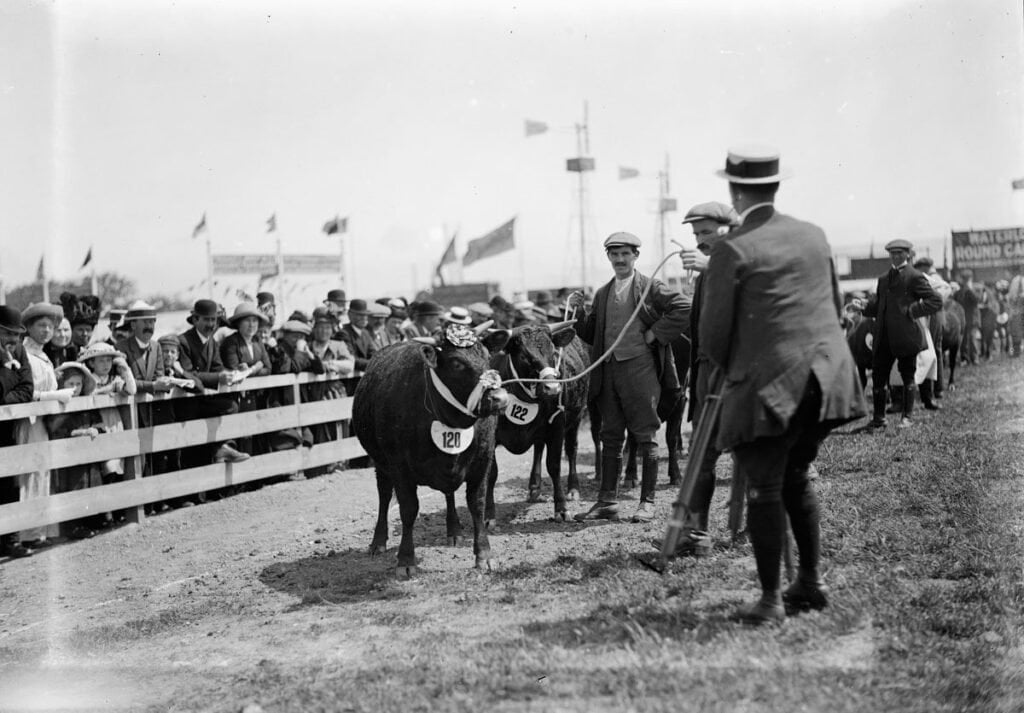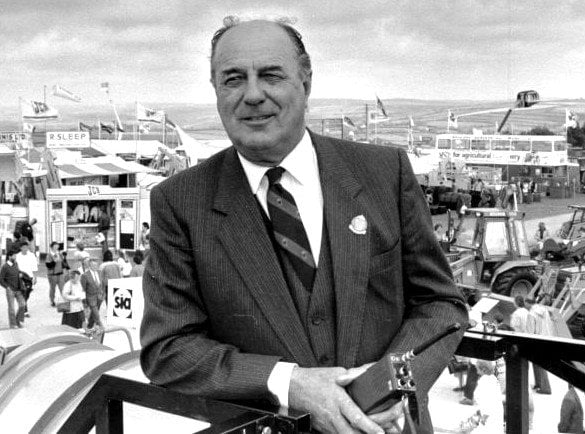Back in the dim and distant past of the late 18th century, Cornwall was quite remote from the heavily populated areas, but it was far from being behind the times. Agricultural societies were springing up all over the country, led by for-ward thinking landowners and those keen to see an improvement in farming methods. Many societies fell by the wayside, but Cornwall can be very proud that over 200 years down the road, its own society, which we all recog-nise as the Royal Cornwall Show, is thriving. Although the bicentenary was celebrated in 1993, it was in 1792 that correspondence between William Lamport of Honiton and Christopher Hawkins of Trewithen laid the foundations of the society. At this time there was no newspaper in Cornwall, so it was in the Sherhourne and Yeovil Mercury and General Advertiser that this following advert appeared which laid the foundations of the show as we know it today: CORNWALL AGRICULTURE and INDUSTRY A Meeting will be held at the White Hart Inn, Bodmin, on Saturday the 1st of December next, for the purpose of taking into consideration a Plan for forming an Agricultural Society in this county: And it is earnestly hoped that all those gentlemen who wish to promote the objects of such a society will give an early attendance. Dinner on table at two o’clock at ls. 6d. per head. Bodmin, November 5, 1792.
Following this meeting a report was published on 10th December 1792 and was distributed all over Cornwall; a copy of it is kept in the Cornwall Record Office in Truro. As a result of this meeting a select committee was formed to look into the question of forming an association and it is here that the title the Cornwall Agricultural Society is first mentioned. That select committee consisted of the follow-ing seven people: Sir William Molesworth, Bart., Sir Francis Basset, Bart., Revd. H. Hawkins Tremayne, Col. Rodd, Revd. Thomas Trevenen, R.L. Gwatkin Esq., and John Thomas Esq. Vice Warden. The meeting of these seven people was called by Sir William Molesworth, of Pencarrow, near Bodmin, and so it is he who should really be recognised as the founder of what we know today as the Royal Cornwall Agricultural Association. Thanks, were given to him at the meeting for “having called the Attention of the County to so useful an Undertaking”. In these very early days, prizes were offered for ploughing – to the best ploughman £3 3s and his boy lOs 6d. It wasn’t until the show in the following June 1794, that prizes were offered for livestock – “Best Stallion, Five Guineas. Best Bull, Five Guineas, Best Ram, Three Guineas, Best Boar, Three Guineas”. This first livestock show attracted entries of 11 stallions, 8 bulls, 12 rams and 2 boars – what a contrast to 1995’s show. Gradually over the next months new classes were added – sheep shearing “the sheep to be provided by the society – the shears by the shear-ers”; turnip growing with the prize awarded to the grower of the highest number of turnips in an area of at least 5 acres “properly hoed and managed in a husbandlike manner”; a prize for the largest quantity of waste land that was enclosed and improved; for the best cow having had two or more calves: the best fat sheep; the heaviest entire fleece of Wool.

By 1800 the society was again looking to improve and expand with 5 guineas on offer to the “person who plants… the greatest number of Acres of Potatoes, in Proportion to the Size of his Farm”; 5 guineas to the owner of the best stocked cyder orchard; 5 guineas to the best essay on how to make cyder, and 10 guineas for the best essay regarding wool production. A further new class introduced in 1801 was the prize for the best threshing machine. This was a major step forward for Cornwall, as there were very few of these machines in existence at this time. Fifty years on, and the show had suffered its ups and downs with different classes coming and going and by the annual Truro show in 1857 times were changing; other parts of the county wanted to play host and the concept of the travelling show was born. The Annual General Meeting in December 1857 heralded many changes, the most signifi-cant of which was the addition of the prefix “Royal” to the name which is where the name which is now synonymous with Cornwall came into being – The Royal Cornwall Show. Her Majesty Queen Victoria had actually been a subscriber to the association from 1848, but it wasn’t until 1863 that the Prince of Wales, Duke of Cornwall, actually attended the show – a tradition which is still carried on today. The show had begun to appeal to a much wider audi-ence and 1859 saw the first show within the show or “section shows” which have proved to be an important part of the Royal Cornwall Show and which now encompass horticulture, dogs, pigeons, bees and honey, rabbits, cage birds and goats as well as the first recorded “section show” of poultry. The first recorded appearance of a silver trophy was in 1860 which was presented for the best 4 or 5-year-old mare or gelding calculated for a carriage.

The award of cups and trophies is, of course, a major part of today’s show. The public catering rights attracted four tenders, in 1875, with the successful bid in the sum of £55 from Mrs. Jenkins of Falmouth, and for the first-time tenders for the copyright of the show catalogue is mentioned. Over 24,000 people paid to attend 1875’s show, breaking all previous records and at the show held in Camborne, 1877, the first of the driving classes were recognised. June 1908 saw the Association celebrating 50 years of migrational shows, some 700 people were reported as being members at that time, and with an ever growing num-ber of classes, the future looked very secure. The cost of staging the show had grown to over £2,000, with just over £800 being distributed as prize money for livestock and implements. September 1910, saw for the first time the reigning monarch as Patron of the Association – the former Prince of Wales was now King George V. The onset of the First World War shed doubts on the show of 1915 which was held at Camborne which did prove surprisingly successful. However, by July 1915, it was decided that no further shows would be staged until “peace had been declared” for the first time with an entrance fee of 4/- each, and also for the first time, members of the press were catered for. Throughout the 1920s gradual changes and improvements were made with the introduction of the provision of accom-modation for herdsmen and grooms, and also car parking sites. Up until this time, every year the equipment needed was bought prior to each show and then sold on, but 1925 heralded the start of contracting the necessary bits and pieces. The contractor, who is still the main contractor to the show today, was the firm of L.H. Woodhouse & Co. of Nottingham. In 1928 it was recorded that the show was held at one of the loveliest sites ever chosen – Trengwainton with the site being “on high ground, beautifully wooded and afford-ing a magnificent view of Mount’s Bay and the surrounding country” and it is here that the first sheep dog demonstra-tions were held in the main ring. The August of 1939 – all the plans were going on as normal for the show in Falmouth in 1940, when War broke out and it was decided “that no show be held in 1940 and that all activities of the Association be suspended for the duration of the War”. The committee met to discuss staging a show in 1945 but due to the national shortage it was decided that no show would be staged in 1946, and it was also found that the costs of staging a show similar to that before the War had increased by 100%. However, all thoughts of doubt were dispelled when over 44,000 people attended the show staged at Truro with a massive profit of £5,000 being recorded, and by 1949 suggestions of purchasing a permanent site were being made. Helston was host for the 1956 show which recorded a record number of 160 trade stands and a P.T. display by R.N.A.S. Culdrose – even though the weather was inclement!

1957 saw the appointment of Albert Riddle as Secretary to the Association following the retirement of Anthony Williams. Along with the need for a full-time secretary, came the need to purchase permanent office accommodation for the work of the Association. Number 4 Upper Lemon Villas, Truro, was purchased but it was 10 years before the secretary and his wife moved to Truro preferring to live in their hometown of Liskeard. The first show under the new secretary saw few changes and many people remember seeing the police dogs put through their paces in the main ring of the showground at Wadebridge – which was to be the site chosen 3 years later as the show’s permanent home. 1958 was the first time that the late Raymond Brooks-Ward’s voice was to be heard and it was to grace the main ring right up to and including the show of 1992 after which his untimely death came as a shock to us all. The last “travelling show”, hosted by Liskeard saw Her Majesty, Queen Elizabeth the Queen Mother in atten-dance. 1960 saw the first show at the permanent site, and by 1961, literally miles of water pipes had been laid, and the showground fenced in – which ensured that everyone entered paid. Work continued on the showground and by 1964 a much-enlarged members’ pavilion – although temporary – was in position – and incidentally, it is still in use today. Over the next few years great improvements to the show ground were made at a considerable cost and due to the ever increasing amount of machinery and people coming to the show, the entrance and exit roads were greatly improved – today the traffic no longer has to pass through Wadebridge owing to the advent of the new by-pass.
Further developments were seen in 1974 with the new offices and house being built on the site and kindly donated by Dean Developments, and a further new class was intro-duced – the donkey classes – and also the provision of a caravan park for exhibitors wishing to bring caravans to the show. It also heralded the first three-day show which proved to be a great success. 1974 and 1975 were exciting times for the Association as the Duchy of Cornwall purchased the site for the reasonable figure of £15,000 for 76 acres, bearing in mind that the Association had already bought some land around the site for car parking facilities. Further develop-ment and land purchases over the coming years has enabled the showground to become the envy of most other shows. 1981 saw the full-time appointment of Christopher Riddle – the author of A History of the Royal Cornwall Show 1793 – 1993 – and by 1985 he was promoted to Assistant Secretary to his father, Albert. Unique in the world of county shows, this arrangement was to continue until late 1989, when on his father’s retirement, Christopher was promoted to the Secretary. Albert remains as a consultant and lives on the showground in the converted Tredinnick farm buildings bought by the Association in 1978. Making a first visit to the show in 1991 was H.R.H. The Duchess of Kent and during a long but informal day at the show, she endeared herself to all those attending.
President for the year, and therefore host to the royal visitor, Peter Prideaux-Brune of Padstow also proved to be a popular figure and is a strong supporter of the Cornwall Agricultural Society. Editor’s Note: We will be featuring an in-depth article on Prideaux House in our next issue – our Birthday Issue – on sale from the 1st July. Also, in 1991, the Association made a generous dona-tion to the R.S.P.C.A. to enable the purchase of a new Horse Ambulance. This is just one of the many generous dona-tions made by the Society since its inception. Christopher Riddle is anxious to point out that what-ever plans are made by him as Secretary, and the officers of the Association, they can only be brought to fruition by the support of the volunteers and organisations who annually give so much time and effort. It is this support over the years that has ensured the success of the Royal Cornwall Show and all those who have taken part in whatever role -exhibitor, steward, helper – should be duly proud of play-ing their part. Cornwall’s Royal Cornwall Show is definitely here to stay. Come along and meet us on our stand number 45 at this year’s Show.